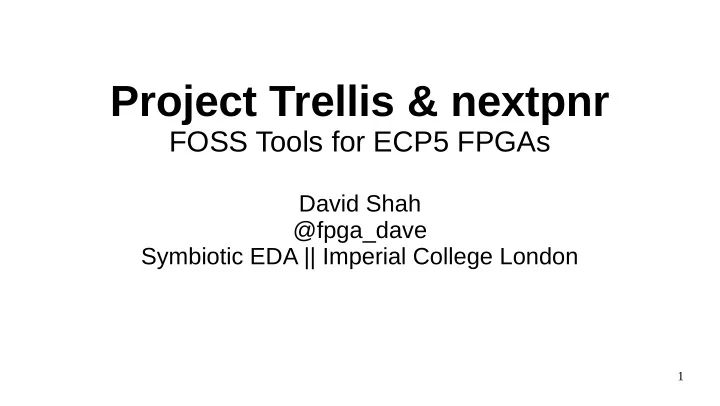

Project Trellis & nextpnr FOSS Tools for ECP5 FPGAs David Shah @fpga_dave Symbiotic EDA || Imperial College London 1
FPGA? ● Programmable digital logic ● Typical basic elements are look-up-tables and D- flipflops; connected by programmable switches ● Configured by a bitstream which sets all this up ● Most FPGA development uses closed-source tools, FPGA vendors don’t document bitstreams 2
ECP5 FPGA ● Up to 85k logic cells (LUT4+carry+FF) ● Up to 3.7Mb block RAM (in 18Kb blocks), 156 18x18 DSPs ● Available with 3Gbps or 5Gbps SERDES for PCIe, USB 3.0, etc ● Single-quantity pricing starts from $5 (“12k” LE) 3
ECP5 Architecture ● Split up into tiles of different types. Logic tiles split into 4 slices ● Slice: 2 LUT + 2FF; carry + 2FF; 16x2 RAM + 2FF; also cascade muxes ● Fixed interconnect wires ● Arcs connect wires together and are configurable or fixed (aka pip ) ● All arcs and wires are unidirectional – mux topology ● Dedicated global clock network connects to all tiles 4
ECP5 Architecture IO DSP RAM Clock Logic Muxes Clock Taps 5 SERDES
ECP5 Architecture Logic tiles contain both logic and interconnect CIB tiles contain interconnect for non-logic functions MIB tiles contain non-logic functionality (EBR, DSP, IO, etc) More than one tile at a 6 location is possible!
ECP5 Architecture 7
Current Status ● Bit and routing documentation for almost all functionality (missing: obscure DSP modes) ● Timing documentation for fabric, logic cells, IO and BRAM ● Timing-driven Yosys & nextpnr flow supporting majority of functionality 8
Database 9
Database Normalised netname Nominal position is x+3 Frame 104, bit 9 inside tile 10
Database 11
Database 12
Text Configuration ● Need to make use of & test fuzz results ● Tools to convert bitstreams to/from a text config format ● Check that output is logical for simple designs ● Check for unknown bits in larger designs 13
Text Configuration .tile R53C71:PLC2 arc: A1 W1_H02E0701 arc: A3 H02E0701 arc: A4 H02E0501 arc: A5 V00B0000 arc: A7 W1_H02E0501 arc: B0 S1_V02N0301 arc: S3_V06S0303 W3_H06E0303 arc: W1_H02W0401 V02S0401 word: SLICEA.K0.INIT 1100110000000000 word: SLICEA.K1.INIT 1010101000000000 enum: SLICEA.CCU2.INJECT1_0 NO enum: SLICEA.CCU2.INJECT1_1 NO enum: SLICEA.D0MUX 1 enum: SLICEA.D1MUX 1 enum: SLICEA.MODE CCU2 14
Timing ● Need to know how large internal delays are to determine if a design can work at a given frequency ● Like bitstream format, not enough vendor documentation ● Delays for cells (LUTs, etc) extracted from SDF files ● Interconnect delays determined using least-squares linear fit 15
Yosys ● Verilog RTL Synthesis Framework ● Support for multiple FPGA families (ECP5, iCE40, Xilinx, ...) and ASIC synthesis ● Uses Berkley ABC for logic optimisation ● Formal equivalence checking and assertion verification ● Plus much more! 16
nextpnr ● New open source multi-architecture place and route tool ● Development started early May ● Aimed primarily at real silicon (unlike VPR) ● Timing driven throughout 17
nextpnr ● Architectures in nextpnr implement an API rather than providing fixed data files ● Choose how you store the device database based on device size and external constraints ● Custom packer and other functions can be architecture-provided 18
nextpnr Arch API ● Blackbox ID types: BelId, WireId, PipId ● getBels(), getPips(), getWires(), getPipsUphill(wire): return “some kind of range” of BelId, PipId, etc ● Range must implement begin(), end() ● Iterators must implement ++, *, != ● Could be anything from a std::vector to custom walker of a deduplicated database! 19
nextpnr Arch API ● Arch code stored in its own folder, different binary for each arch built ● Enables heavy compile-time optimisation and arch-specific types compared to virtual functions ● Avoids n² build complexity of C++ templates 20
nextpnr ● Support for iCE40 and ECP5 FPGAs ● Very experimental 7-series support with Torc/XDL ● Future “generic” architecture will allow building FPGA using Python API 21
nextpnr ● Started over the summer with “blank canvas” PnR – SA placer and vaguely A*+ripup router ● Now working on improvements including path-based timing-driven detail placement; analytical placer; SAT-based packing/initial placer…. ● Python API for extensions, constraints, custom manipulations, algorithm prototyping 22
nextpnr 23
24
Links Trellis: https://github.com/SymbiFlow/prjtrellis Data: https://symbiflow.github.io/prjtrellis-db/ Yosys: https://github.com/YosysHQ/yosys nextpnr: https://github.com/YosysHQ/nextpnr Slides: https://ds0.me/fosdem19.pdf 25
Recommend
More recommend